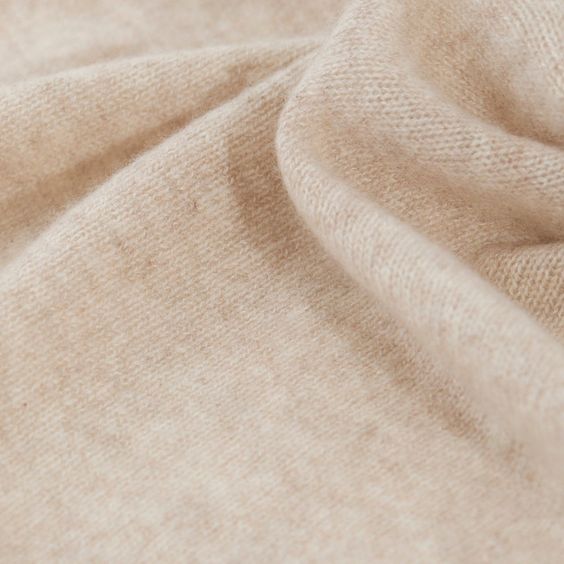Recycling is generally an eco-friendly option, but in the case of cashmere, it’s essential to consider all facets of its environmental impact.
First of all, cashmere is a type of wool and all 100% wools are biodegradable. It takes about 4 months for a cashmere sweater to decompose in a good composting unit, and it will also make excellent fertilizer.
It’s also important to keep in mind that wools are naturally renewable. Therefore, the question of recycling arises with less intensity, because wools do not deplete the planet. Therefore, it is permissible to question the cost-benefit of recycling cashmere.
To our knowledge, there are three types of recycled cashmere:
The one that comes from cashmere items that have been worn.
These end-of-life sweaters are directed to channels specialized in recycling. They undergo a reverse process to be transformed back into fibers. Then, these fibers will undergo a typical production cycle but will additionally need to be bleached and then redyed because they come from sweaters of different colors.
In principle, this solution is eco-friendly. However, there are four constraints that raise questions:
- A problem of pilling and longevity: since it mixes Uniqlo cashmeres at €75 and Loro Piana cashmeres at €950 (the 2-ply V-neck), the quality is necessarily heterogeneous in both fiber length and thickness. However, a good cashmere yarn must have stability in the fiber.
- An environmentally unfriendly process: the bleaching operation, termed “bleaching” (a term that is not directly translatable into French, but implies the use of active ingredients similar to bleach), besides being highly polluting, leads to the weakening and shortening of the fibers. Bleaching is used by discount brands to turn dark cashmere, bought at a low price, white. For example, at Mahogany Cashmere, we NEVER use fibers resulting from bleaching, which explains why we never offer fluorescent colors, which can only be achieved in this manner.
- A high water consumption: the unraveling and bleaching process is highly water-intensive.
- And ultimately, the use of 40 to 60% new cashmere to stabilize the recycled cashmere. Similar to recycled plastic, which requires about 60% new plastic, we will mix the recycled cashmere with new cashmere to improve pilling and longevity.
This recycled cashmere will ultimately be very expensive and not particularly environmentally friendly.
The second type of recycled cashmere comes from the waste generated during the transformation of the fiber into yarn by the spinning mills.
- During the yarn production process in spinning mills, the shortest and finest fibers fall before becoming yarn. This cashmere has the merit of being pure and does not need to be chemically treated. Disadvantage: the fibers are very short and extremely difficult to work with, resulting in a lot of pilling. Consequence: to recycle these fibers, they are blended with 50% high-quality cashmere yarn. In the end, we will have a sweater with a high price and lower quality because a proportion of the fibers will be too short.
- This way, we manage to recycle 50% of the cashmere. The quality will be inferior to 100% cashmere in terms of durability, longevity, and pilling, but there won’t have been any bleaching, and there will be significant savings in transportation, as the recycling is done within the production unit.
On a strictly ecological level, this solution appears to be at least as relevant as the previous one.
Recycling from failed sweaters or end-of-spools of yarn.
In production, prototypes fail, some sweaters don’t pass quality control, and some yarn spools at the end of their production cycle can only produce a few sweaters. That’s the case with our Nepalese knitter. All these yarns, which have a standard quality (this information is very important), can be easily connected end-to-end and used to make quality sweaters.” The only problem: these yarn assemblies come in all colors.
Solution: It’s very easy to dye the colors into navy blue or black.
At Mahogany, this is the project we’re working on: offering you a collection of sweaters made from 100% recycled cashmere, without any addition of new cashmere, with real stability over time and minimal pilling, without bleaching or overfinishing.
The only constraint: the collection will be in black and navy blue. We can’t have it all!
But it will truly be eco-friendly.
We thought we would be ready by 2023. But it will most likely be for 2024/25.
At Mahogany, we believe that so far, the recycled cashmere from the first two solutions has not provided satisfaction, both in terms of ecological impact and quality.
Without even mentioning greenwashing, the sale of items made from recycled cashmere allows brands to have a form of ecological label that saves face but does not lead to progress in substance. That’s why we still don’t work with it, apart from our upcoming black and navy blue collection project.
This article was written in October 2023. Science evolves, and we are not stubborn. It seems that some industrialists are working on new techniques that would allow for the production of high-quality recycled cashmere. Dear industrial researchers, we appreciate you, and if you are reading these lines and have achieved a high level of quality within a truly ecological approach, we are more than open to collaboration: please contact us!
Our other articles on Cashmere
All about Grade A Cashmere
Cashmere trends
What is organic cashmere?





